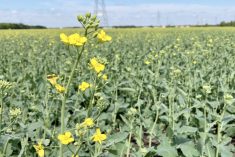Canola acres may have been down in North Dakota this year, but good growing weather throughout the year are reported to have resulted in a “phenomenal” crop overall.
Area planted to the crop in the major canola-growing state came in at only 850,000 acres, which compares with the nearly 1.5 million acres seeded the previous year.
However, while acres were down, Barry Coleman, executive director of the Northern Canola Growers Association at Bismarck, N.D., said he wouldn’t be surprised if average yields topped a record 2,000 pounds per acre.
Read Also

Senft to step down as CEO of Seeds Canada
Barry Senft, the founding CEO of the five-year-old Seeds Canada organization is stepping down as of January 2026.
Average yields only reached 1,425 lbs./ac. in 2012 and the previous record topped out at about 1,811.
“We’ll definitely break that record by several hundred pounds,” said Coleman. He said cooler weather in July helped canola see a long flowering period, which boosted yields overall.
A lack of problems with aster leafhoppers aided production as well, said Coleman.
From a pricing standpoint, he said the large crop wouldn’t necessarily depress prices, as much of the direction will continue to come from soybeans. Increasing demand from domestic crushers in the state was also expected to underpin values.
While the harvest is complete in most areas, about 40 per cent of the canola crop was still in swath in some northern areas along the Canadian border, Coleman said.
— Phil Franz-Warkentin writes for Commodity News Service Canada, a Winnipeg company specializing in grain and commodity market reporting.



















